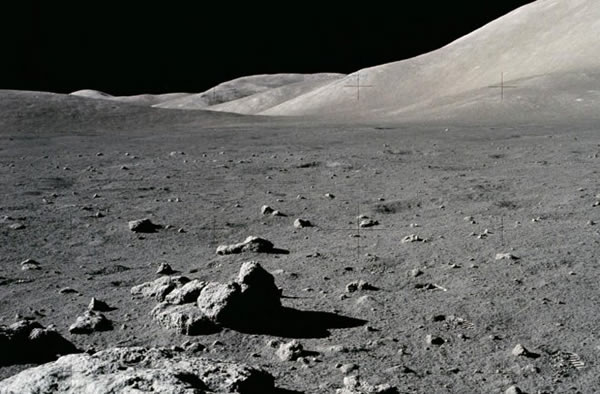NASA Plans to Make Water on the Moon
NASA is developing a lunar rover to find and analyze water and other materials trapped in deep freezes at the moon’s poles and to demonstrate how water can be made on site.
Slated to fly in November 2017, the mission, called Regolith and Environment Science and Oxygen and Lunar Volatile Extraction (RESOLVE), will have a week to accomplish its goals.
To stay within a tight $250 million budget cap -- including the rocket ride to the moon -- project managers are planning to use solar energy to power the rover’s systems and science instruments. However, sunlight on the places where water and other volatiles may be trapped only occurs for a few days at a time.
Not so parched? The dry-looking lunar landscape as seen by the Apollo astronauts.
“To do a mission of any significance (at the lunar poles) it would take nuclear power, but we don’t have that kind of money,” said William Larson, a recently retired project manager at NASA’s Kennedy Space Center.
“Solar-powered missions are more affordable and that’s the way we’re going to try to go,” Larson said.
That leaves scientists with long to-do list and a very tight timeline.
Upon landing on the moon, the rover would have about 2.5 days of sunlight to get started searching for hydrogen, then hibernate for two days of shadow. The rest of the mission would play out over the next five days of sunlight and would include drilling about 1 meter (3.3 feet) deep into the ground to extract a sample for mineral analysis.
The sample also would be heated in hopes of producing liquid water. Finally, the rover would demonstrate how oxygen can be chemically pulled out from the lunar soil and mixed with hydrogen to produce water.
“The primary mission is lunar ice prospecting, but since we’re there and since we don’t know if we’ll find water, we wanted to also demonstrate that we can extract oxygen from the lunar soil,” Larson told Discovery News.
“That is the most challenging timeline of any surface mobility mission NASA has ever attempted before -- and we’re trying to do it on the cheap,” he added.
RESOLVE builds upon the ongoing Lunar Reconnaissance Orbiter mapping mission and the 2009 impacts of its companion LCROSS spacecraft and rocket motor into a permanently shadowed crater called Cabeus, located near the moon’s south pole. LCROSS is an acronym for the Lunar Crater Observation and Sensing Satellite.
Material blasted above the crater’s rim during the impacts and other analysis showed the crater contains about 5 percent frozen water. The origin of the water, however, remains a mystery.
RESOLVE may provide some answers. The rover’s science instruments are designed to analyze hydrogen isotopes in any water recovered, an experiment that may at least narrow down the options of where it came from. The theories range from water-rich comets and asteroids crashing onto the surface to indigenous water supplies inside the moon that were transported during past volcanic eruptions.
The mission also is expected to provide some ground truth for ongoing efforts to determine what minerals are on the moon.
“The polar regions of the moon are extremely cold. This is of very great interest because there’s the possibility for trapping a wide range of volatiles in these areas,” said lunar scientist David Paige, with the University of California at Los Angeles.
“We know it’s cold enough on the moon to support these deposits. The question is are they actually there,” he said.
Larson outlined the RESOLVE project at the Lunar Superconductor Applications workshop in Cocoa Beach, Florida, this week. NASA plans to partner with the Canadian Space Agency on the project. A simulated mission was conducted in Hawaii this summer.
Apr 12, 2013 07:50 PM ET // by Irene Klotz












